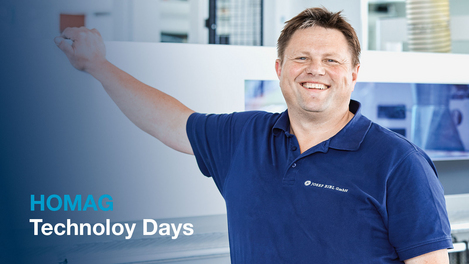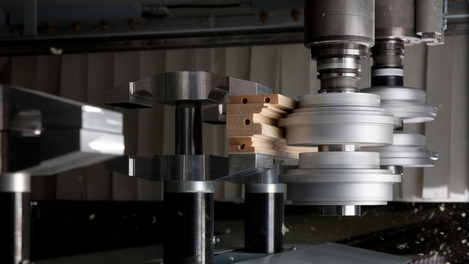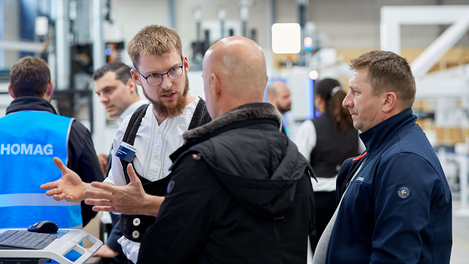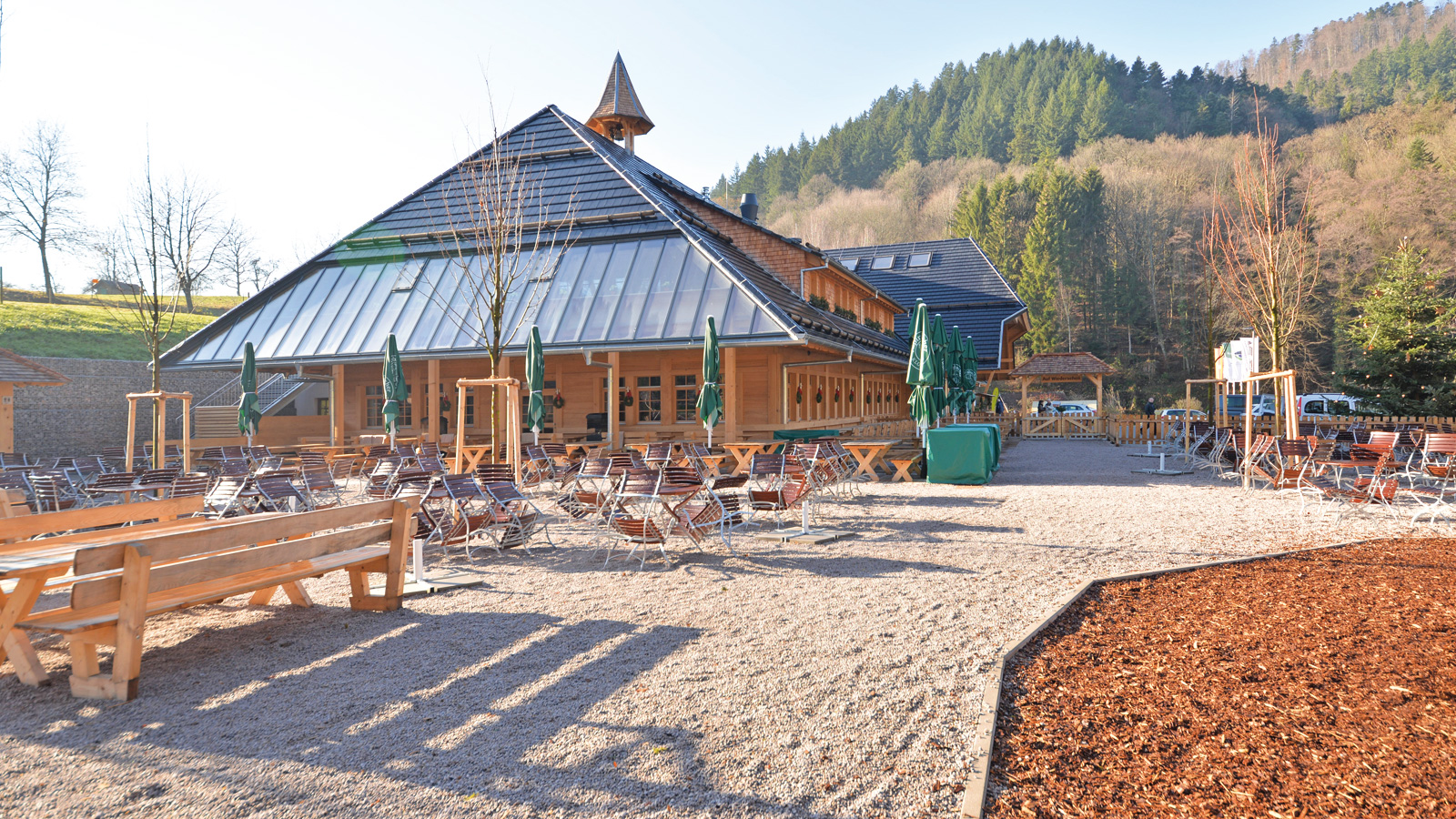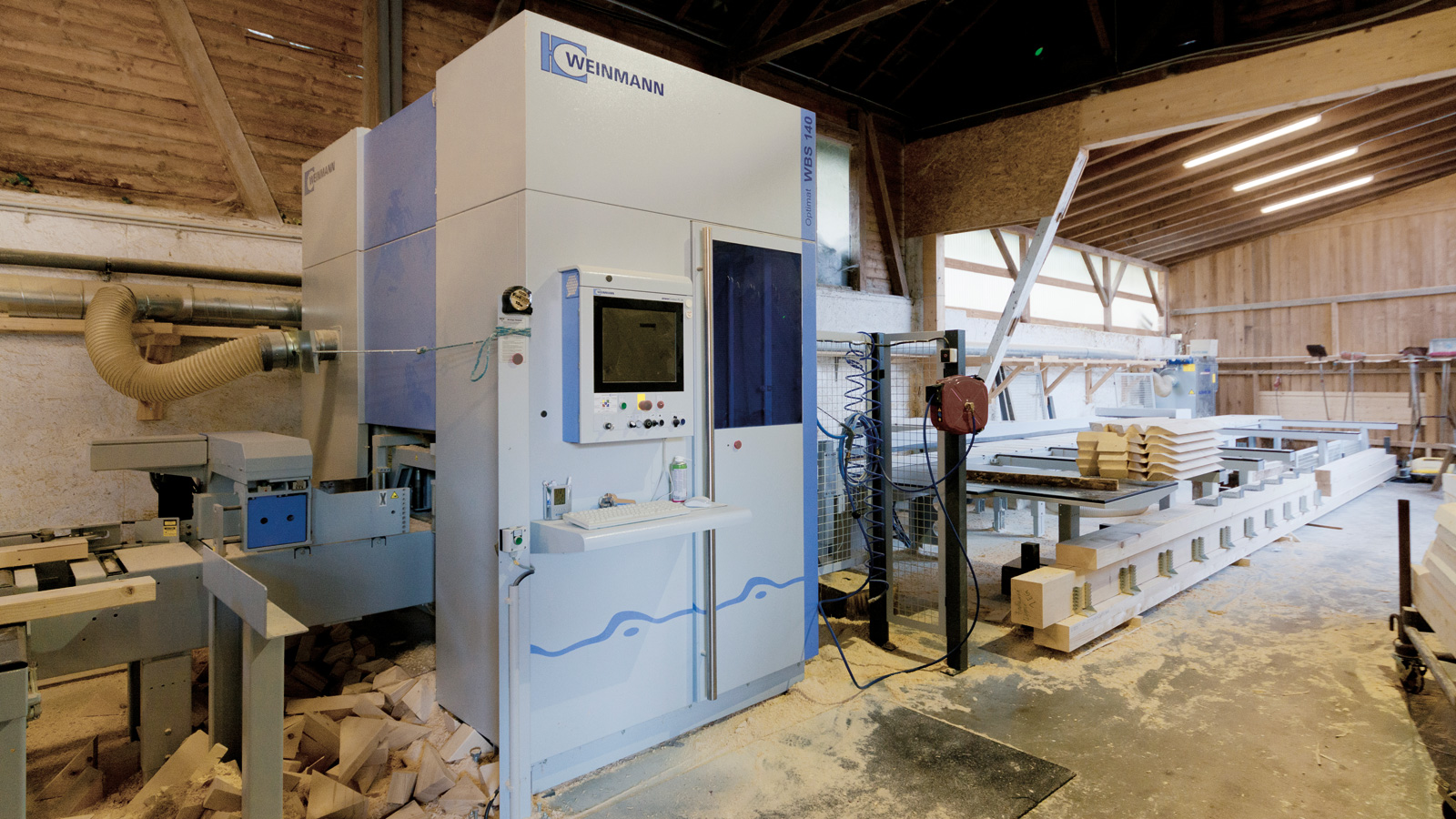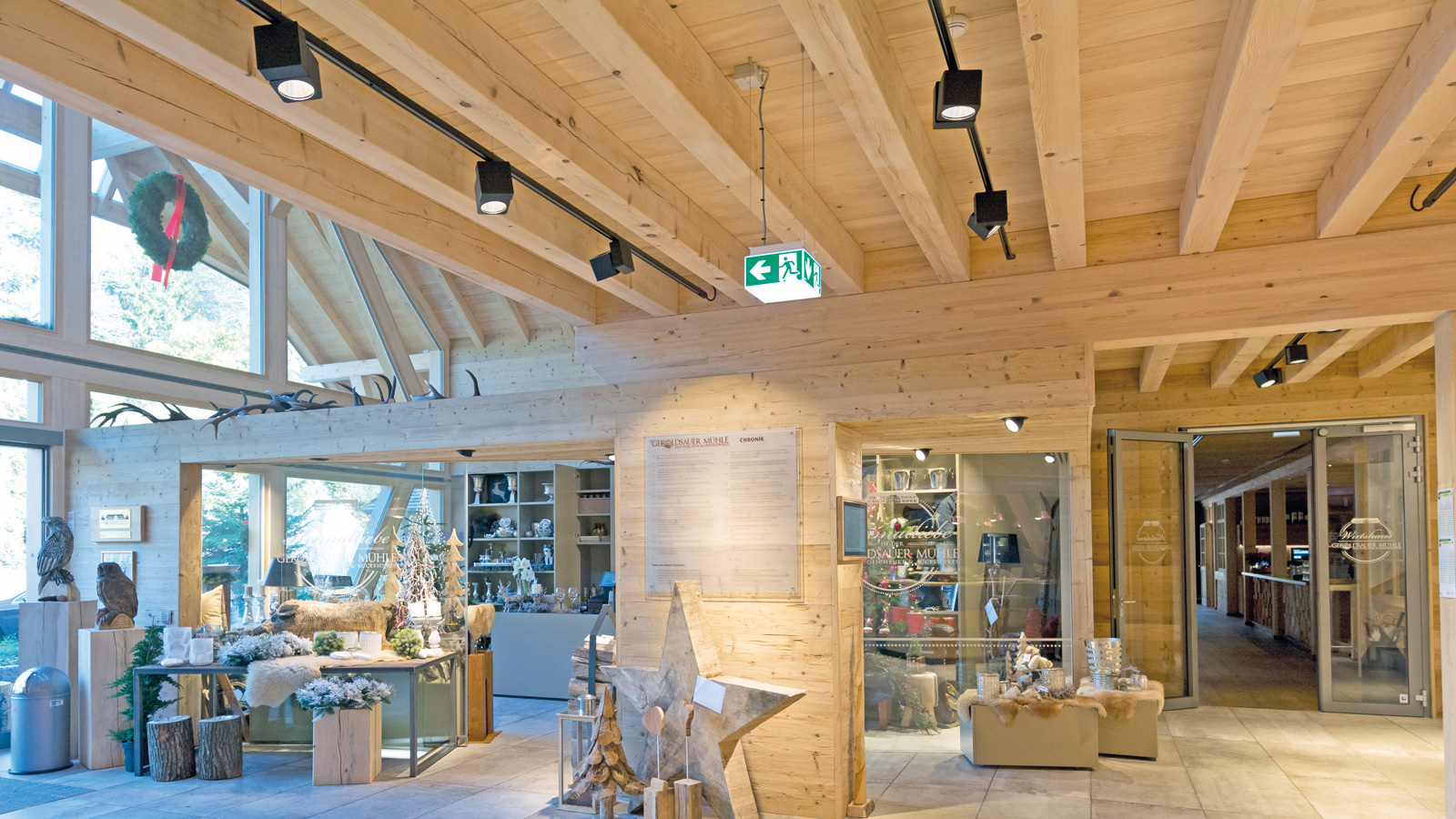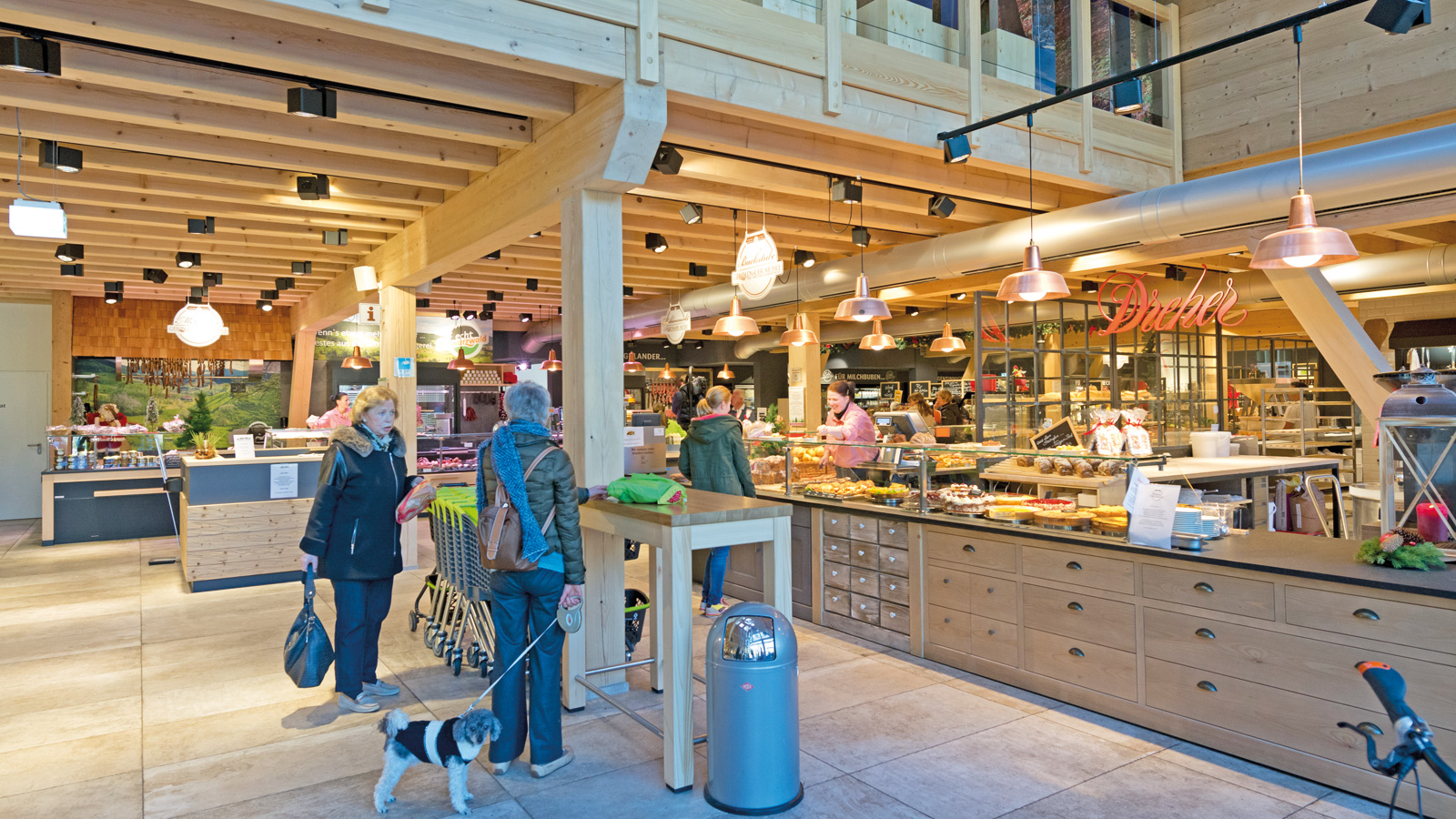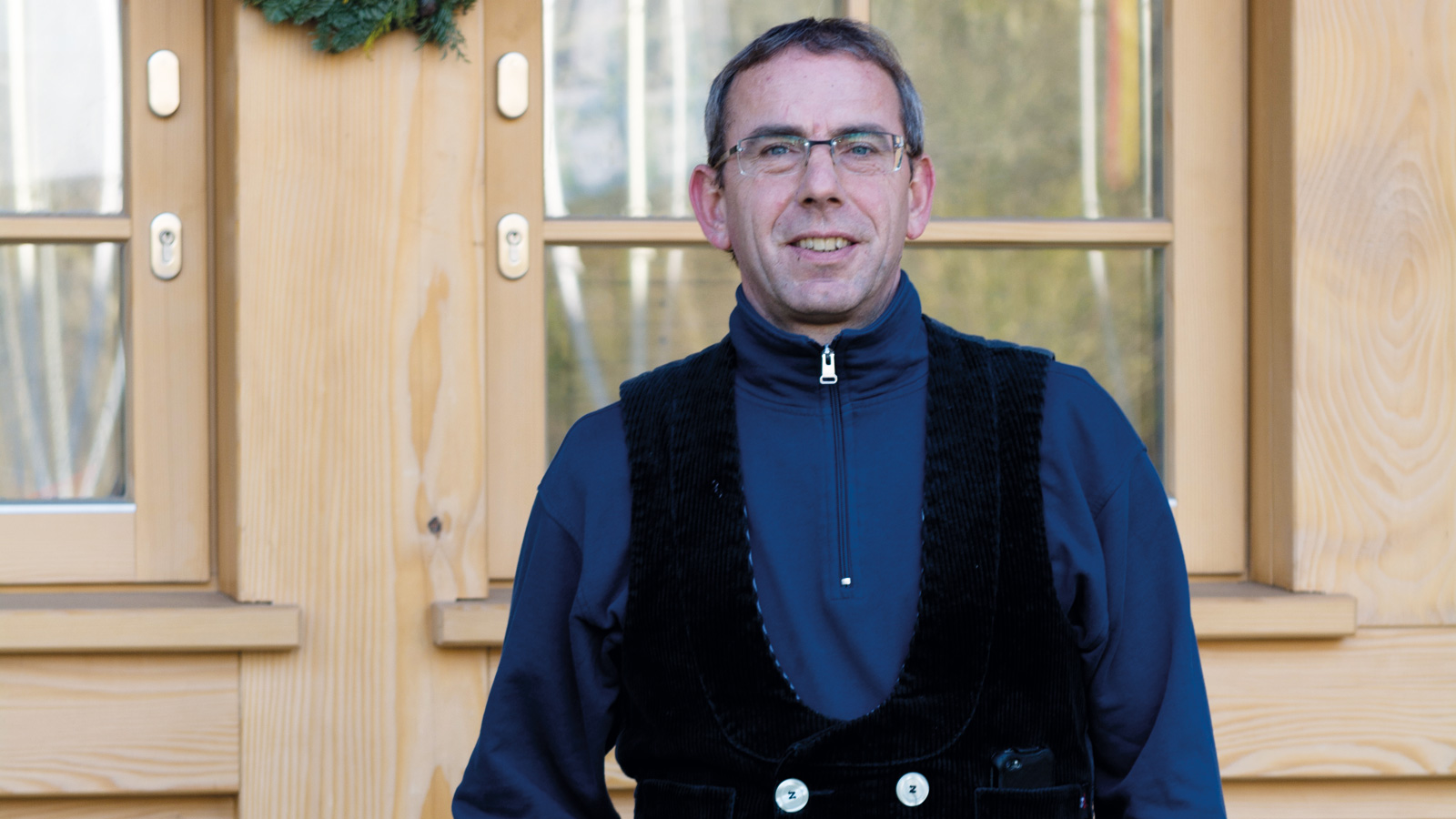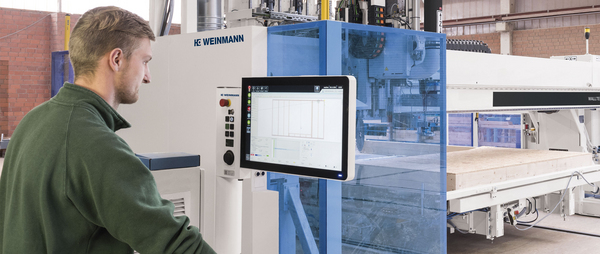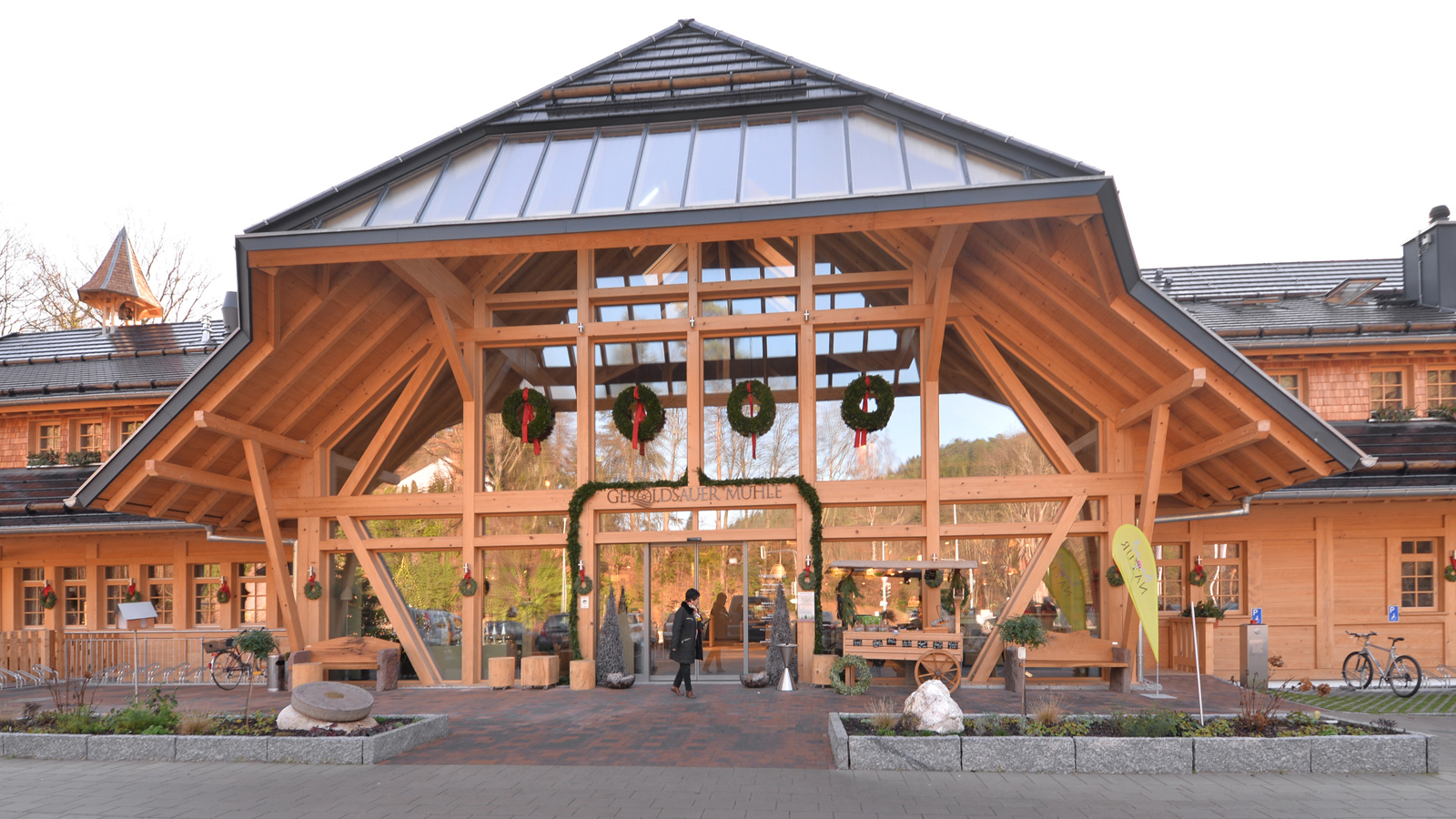
weingärtIn 2015, managing director Roland Weingärtner completed a highly regarded project: the Geroldsauer Mühle, reputedly the largest silver fir building in Germany.
The Geroldsauer Mühle is a market hall for fresh, traditionally produced food from regional farmers, cooperative wine growers associations, and hunters. The site operator's claim of a sustainable, ecological, and innovative existence is not only honored by the products on offer but also by the local construction material, the silver fir. The sales rooms also house a butcher and a baker and the left wing contains a restaurant, which includes a function room on the upper floor.
This level also has comfortable guest rooms for up to 18 event or vacation guests. The guest rooms are also available to participants of seminars, with seminar rooms in the roof space of the Geroldsauer Mühle.
From an architectural perspective, the building is divided into three parts: to the left and right of the entrance there are two long side areas and the center of the building is formed by two gables of which the front one is fully glazed. The exterior dimensions are approximately 16 x 60 m.
From a design perspective, the side areas are made from a timber frame construction with wall elements that are up to 11 m long. The wall construction from the inside to the outside is as follows: an inner panel made of chopped timber boards, a 40 mm installation level, an OSB panel as an airtight level, a 160 mm timber frame construction with cellulose insulation, a 60 mm soft fiber panel, a 30 mm thick rear ventilation level. The outer layer of the wall is a facade in typical Black Forest post-and-plank construction with prefabricated elements hung in front of the timber frame walls. The two-part facade elements are connected to one another with lap joints.
Wide sales rooms and cozy alcoves
Behind the front of the front gable, a timber skeleton construction glazed to the apex, the actual market hall begins. The entrance area opens out into a space that extends vertically to the apex. Behind this is the open sales room with a ceiling that is supported by 240 x 680 mm thick glued laminated timber.
The ceiling beams are suspended in these trusses. The glued laminated timber spans up to 15 m, with the distance between the seven axes 5m in each case.
In the center of the room the glued laminated timber rests on a number of supports, and at the front and the back on diagonal braces. Steel ties at the base of the braces absorb the shearing forces.
The ceiling above the open market hall is designed as a fixed panel. To enable this, the timber boards were designed with tongue and groove connections and connected to the ceiling beams and joists with nails and Spax screws. Brace intersections (160 x 160 mm) in one of the fields provide additional horizontal rigidity.
In the restaurant area, which is divided into cozy alcoves and side rooms by partition walls, a 180 mm thick laminated timber ceiling was installed.
Around 12,500 meters of silver fir timber
The trigger for the Geroldsauer Mühle project was an inquiry from the city of Baden-Baden. In 2013, the city was looking for a sponsor for a small market barn among the part-time farmers in the region. Back then, together with his brother Martin, who as a breeder of Scottish highland cattle wanted to take over the sponsorship, Roland Weingärtner submitted an initial design for a 12 x 25 m building to the Baden-Baden town council. "The design was received enthusiastically", remembers Roland Weingärtner today. After his brother purchased the mill site with an old hotel in the same year, the project grew to its current size.
Weingärtner integrated around 12,500 m of bound silver fir in the design of the Geroldsauer Mühle alone, which equates to a timber volume of approximately 30 m³. No easy project for a company with six employees plus the boss that is normally involved in roof renovations, classic carpentry, agricultural timber construction, and building detached houses.
Without machine support, Roland Weingärtner "would never have dared take on a project of such dimensions. A project like this is not possible with manual joinery, and even with beams purchased from the beam processing center, I was not inclined to take the project."
Tailor-made machine for small companies
However, the carpenter had already been thinking about buying a carpentry machine for some time, which is why he saw this big project as a welcome reason for buying a WEINMANN carpentry machine WBS 140. One argument in favor of this machine is that it is a tailor-made solution for small and medium-sized carpentry businesses: fitted with a five-axis unit and an eight-position tool changer, it offers maximum flexibility. This means that a large proportion of the complex beam processing that has to be done in this company can be done on one single machine.
The low space requirement for the machine is also an advantage for small to medium-sized carpentry businesses. This was exactly the case for Weingärtner Holzbau: "We were able to buy the machine without having to do any expensive hall modifications, especially as the machine doesn't require any special floor, reinforced foundations, or even a pit underneath the machine," remembers Roland Weingärtner. "As the price was also affordable and WEINMANN is located nearby, the decision was obvious for me."
More flexibility in element production
Before serious work began on the Geroldsauer Mühle project, the employees at Weingärtner Holzbau began to familiarize themselves with the new technology in a sample project. They were surprised from the start: "We did not think that the data transfer with the Weto Viskon software that we use would be so smooth from the very beginning," remembers Roland Weingärtner.
The carpenter was also impressed by the user friendliness of the machine: "Naturally, you call the service team at the beginning because you don't know which button to press. But that soon stops because you receive good advice and the machine is easy to operate. When the employee tasked with using the WBS 140 attended the master training, I was easily able to take over his tasks. For me, that means that the overall package for the machine is right, including remote diagnostics via Internet and a prompt delivery service for spare parts."
The advantages of fully automatic beam processing became obvious to Roland Weingärtner once the mill project had started. The fact that the WBS 140 can be operated by one employee and even automatically (i.e. with no personnel involvement) as an option paid off. The employee in the hall was able to put the timber frame elements together on the inhouse assembly table while the machine completed the beam processing for the next element.
However, that only works if, as is the case at Weingärtner Holzbau, all components are run through the WBS 140 element by element. Advantages in element assembly make up for slight disadvantages in cut optimization. The latter also works in this procedure if you place remaining wood for the next element on the supply roller conveyor as the first component and enter the length in the machine.
In Baden-Baden, the material supply and outfeed are designed for components up to 13.70 m in length. But Roland Weingärtner has already run 18 m long angle rafters through the machine: "However, to allow us to process this length, we had to cut holes in the hall walls."
In the Geroldsauer Mühle project, Weingärtner originally planned to erect the three tracts in succession from right to left. However, there was a delay in the completion of the lift shaft in the central tract. "As the clock was ticking for my brother, we couldn't afford to wait for the lift shaft to be completed. We had no choice; we had to put up the left side tract after the right one."
The in-house beam processing technology allowed the timber construction specialist to rear-range the element production. "We're now more flexible than the beam processing center." Weingärtner's decision was also reaffirmed by the fact that the central tract, which was erected at the end between the two outer tracts, fitted in the "gap" like a glove: "At the end, there was a difference in length of 4 mm across the entire building, which is of course down to the precise measuring with rope and tape measure."
More capacity with less personnel
After the mill project, three employees at Weingärtner Holzbau succumbed to longterm illnesses at the same time. "Our apprentice was at school most of the time, we had a lot of projects, and it's impossible to get staff these days. Nevertheless, thanks to the short beam processing times, we had no difficulty in completing our orders.
For example, I put together a pergola with groove joints and struts in half a day and still managed to do other activities in the hall. If the work had had to be done manually, it would have taken two employees one and a half days for the beam processing alone — this is time that we definitely would not have had."
Roland Weingärtner would have had difficulty completing a garage with a hipped end roof, jack rafters, and angle rafters at that time as well. Previously, it would have taken two employees two days to complete the beam processing, but with the machine, one employee was able to complete the beam processing in six hours.
There were further time advantages in assembly. With regard to the garage, the three-man assembly team was able to celebrate completing the roof after a good two hours because all parts fitted perfectly thanks to prefabrication — "The prerequisite for this of course, is that you do your homework diligently in terms of the work preparation. Previously, we wouldn't even have been able to think about fitting in a project at a day's notice. Today it's no problem."
Conclusion
Many of the details of the Geroldsauer Mühle illustrate that Roland Weingärtner has made use of the possibilities offered by his carpentry machine to a great extent. They include, for example, a precisely finished "bell tower" and exact, statically relevant fitting connections for the beam offsets in the function room, the clean lap joints and windowsill connections in the facade elements, and the double-roof over the gables, each with two overlapping valley rafters.
The WBS 140 completed the trimming and grooving of a 15 m long rafter in just six minutes: "My cell phone rang when we were processing the first beam and I had to leave the hall briefly — I missed the show completely!"
Using the machine, and with support from two free colleagues on the construction site, Roland Weingärtner completed the timber construction of the Geroldsauer Mühle in three months: "We placed the first element on September 22 and we closed the roof by Christmas." The construction time for the entire building, from the laying of the foundation to the opening at the end of August 201, was around 15 months.
An impressive performance considering the personnel available. This is plausible when you consider the fact that the carpentry business has doubled its beam processing and assembly capacity from 6000 meters of timber to more than 12,000 meters since purchasing the machine.
Once again though, even the best technology can only be as good as the imagination of the person using it. And Roland Weingärtner's imagination is extremely active, meaning that he is always discovering new possibilities for using his carpentry machine.
"At the moment, we are producing braces for a roof renovation, for example. The WBS 140 produces all of the valley floors and jack rafters, miters, and triangles right up to the roof battens. All we had to do was plan all of these elements in the work preparation once and we were then able to produce all of the braces with this data record. In comparison to manual production, the cost advantage benefited not only us — it also allowed us to give a good customer a cheap price."
Roland Weingärtner now also produces stair components automatically, and at the moment he is looking at prefabrication of a 50 m long wooden walkway: "We can run almost every single part through the machine and prefabricate the entire grid in the hall. You only realize what you can do with the machine once you've got it."
And, because ultimately the machine cannot do everything, the carpenter is not losing his craftsmanship: "For example, the machine cannot always saw out curves on large angle rafters due to the geometry involved. We use the saw blade to score the curve and then we saw it precisely by hand. And don't forget, we perform all beam processing in-house now. If you have to purchase the cut beams, you become an assembly business; we are developing in exactly the opposite direction."
Published in Performance, issue 2016
Many thanks to the Editor Dr. Joachim Mohr
Many thanks also to our customer Weingärtner Holzbau
Pictures: Weingärtner Holzbau / Dr. Joachim Mohr
Videos
“We were able to buy the machine without having to do any expensive hall modifications, especially as the machine doesn't require any special floor, reinforced foundations, or even a pit underneath the machine.”Roland Weingärtner, Weingärtner Holzbau
Downloads
Founded in 1999 the company which is based in Baden-Baden has today 6 employees. Weingärtner Holzbau operates in the fields timber construction, roof restoration, pergolas, garages and dormers.
Website Weingärtner Holzbau
